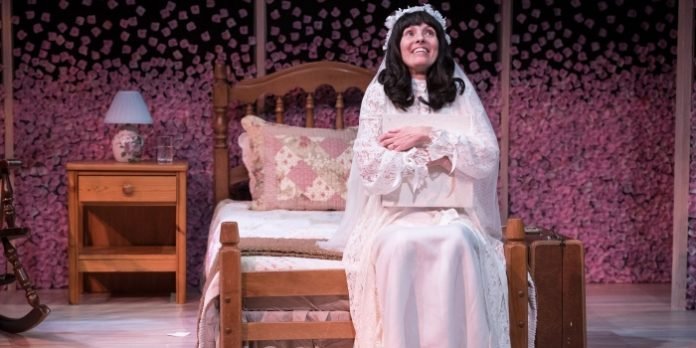Its witty poster, displaying the torso of a young, modestly dressed bride … in handcuffs, suggests a daring exploration of marriage. Instead however, it represents an indictment of the Quiverfull Christian movement and its exploitation of underage girls. Quiverfull tenets are similar to those in Queen Victoria’s heyday, when girls could legally marry as young as twelve to men as old as fifty, with the ‘consent’ of their parents. They were beholden to their husbands for their status, security and survival. And it was not uncommon for them to bear twelve or more children. This is also the case with the more modern Quiverfull Christian movement.
The set, designed by Carolyn Rapanos, aptly reflects the chocolate box conception of marriage held by the naive, deeply religious fifteen-year-old virgin bride-to-be, Maranatha. She yearns for the arrival of her twenty-eight-year old fiancé who will sweep her off to their wedding in the Quiverfull Church; but only after an unspecified celibate waiting period imposed by Maranatha’s father.
CJ McGillivray’s sound design plays out as Maranatha waits impatiently in a hotel room day after tedious day, through countless stage blackouts, echoing recorded bell chimes, and repetitious phrases sawed loudly on a cello. Although the play is set in summer, the only vaguely recognizable tune is that of a Christmas carol: Rejoice! Rejoice! Emmanuel has come to thee, O Israel. If the oft repeated refrain is intended to suggest the fiancé is Emmanuel and Maranatha is Israel, it is rather blatant and overworked.
The program notes which are efficient and informative make interesting reading, particularly in discovering how Rosemary Rowe’s script evolved. They indicate that the play might present a one-sided, repetitive argument. It does.
The wedding cake and fresh fruit served following the performance extends the auditorium performance as it moves into the foyer and bar. If the serving of wedding cake continues through the run, perhaps it could even be a tad stale. After all, poor Maranatha has been cooped up in a hotel room awaiting her groom for forty long days and nights.
Ninety minutes with a single forlorn protagonist is asking a lot of an audience, particularly when an intermission could have provided an opportunity to indicate the passage of time by showing the degradation, both external and internal, of the unfortunate bride-to-be. One yearned for Maranatha’s white wedding dress to get grubby, at least at the knees after all her kneeling in prayer.
The uninspired music between scenes could have been augmented by upbeat evangelical hymns from Maranatha’s Sunday School days or others that might have reflected her mood swings from ecstatic to optimistic and from hopeful to desperate.
Marisa Emma Smith is a versatile actor, but the required suspension of belief is too great to believe her as a fifteen-year-old virgin. With many capable young teen actors, casting one in the role of Maranatha would have lent Rowe’s script much more authenticity, particularly when there is no need for the character to age during the course of the action. She’s only, after all, incarcerated for those proverbial forty days and forty nights. In her attempt to ‘young-down’, Smith chose to deliver her speeches in the fast-speak of modern-day Canadian youth, which resulted in the loss of a significant number of lines.
The humour in Rowe’s script is often childish and cruel, with its sexual double entendres in poor taste. At times the attempts at humour cloud the intent of the play, which we assume is to denounce the practice of underage marriage. For instance, the bride is intrigued and excited by overheard love-making from an adjacent room and constant references to a different possible suitor.
Overall, the arguments The Good Bride presents have already been aired, many times. The subject needs to be explored from other, more original, more dramatic angles if it is to make any difference.
The Good Bride by Rosemary Rowe. An Alley Theatre and Firehall Arts Centre production. On stage at the Firehall Arts Centre (280 West Cordova St, Vancouver) until March 9. Visit firehallartscentre.ca for tickets and information.

